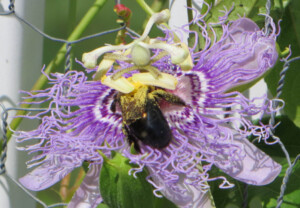
Everyone recognizes the iconic orange and black monarch butterfly or the black and yellow European honeybee as pollinators, but many birds, butterflies, moths, beetles, flies, wasps, reptiles and even small mammals like bats can provide pollination services as well. Over 75% of all flowering plants are pollinated by animals. It is estimated that one out of every three bites of food we eat is the result of pollinators. What exactly is pollination, you ask? Pollination occurs when pollen is moved from the stamen or male part of a flower, to the stigma or female part of the same flower or to another flower of the same species. This causes the plant to produce seeds, nuts or fruit for reproduction. Some plants are able to self-pollinate, while others may be fertilized by pollen carried by the wind. But most flowering plants require a little extra help, and they have developed a myriad of techniques to attract pollinators. Wild Ginger (Asarum canadense) and Pawpaw (Asimina triloba) flowers have evolved to mimic rotten meat in color and scent to attract flies and beetles. Sphinx moths, on the other hand, prefer pale or white flowers that open in the evening and have a sweet smell. While some pollinators intentionally collect pollen, others move it unknowingly when it sticks to their body as they search for food, shelter or even a mate. Passionflower (Passiflora incarnata) is mainly pollinated by carpenter bees. Its flower shape matches the size and shape of the bee in such a way that pollen is deposited onto the back of a nectar-collecting bee and is carried to the next flower. Pollinators have evolved alongside native plants and have developed intricate relationships with them. In fact many pollinators only feed on specific native plant species. Up to 45% of native bees are considered pollen specialists, only using pollen from one species (or genus) of plants. Because hummingbirds specialize on nectar feeding, they play an important role in pollination. These small migratory birds serve as a link between plant populations by visiting flowers and moving pollen over great distances. The red color of Wild Columbines (Aquilegia canadensis) isn’t generally attractive to most pollinators, but Ruby-throated hummingbirds seek out that flower because their long beak and tongue are perfectly suited to its shape. Pollinators are considered keystone species, because many other species depend on them. They are vital to maintaining healthy ecosystems. Unfortunately their numbers are diminishing. You have probably heard of the decline of monarch and honeybee populations, but many of our other pollinators are in decline as well due mainly to loss of habitat as well as pesticide and herbicide use, pollution, disease, and climate change. Pollinators need our help! What can you do?
- Plant native plants and remove invasive plants.
- Eliminate or limit the use of pesticides and herbicides.
- Reduce the size of your lawn.
- Provide nesting sites.
- Use amber or yellow lightbulbs in outdoor fixtures.
- Tell local and state government officials that you care about pollinator health.
- Inform and inspire others.
Pollinator Week is an annual event celebrated internationally in support of pollinator health and takes place June 21-27, 2021. Nic Patton
